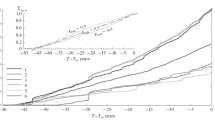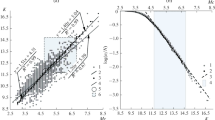Abstract
The regularities are revealed which, based on seismic statistics, govern the evolution of the dynamics in the preparation of strong earthquakes within discrete closed volumes of the lithosphere (seismic systems, SSs). This concept was previously formulated as a phenomenological approach based on seismic entropy for real-time monitoring the strong earthquakes. The seismic parameters of cumulative energy and entropy contain the energy–time memory about the previous earthquakes within the considered volume, which allows the real-time description of the nonequilibrium spatiotemporal dynamics of the active volume of the Earth’s lithosphere. The power law relating the information entropy and cumulative energy is theoretically derived, which supports the previously established empirical relationships. In the SSs, the strong earthquakes pertaining to a certain magnitude interval are united into the ensembles forming the seismic cycles which periodically restore the equilibrium state of the system. With the lapse of time, the strong earthquakes of the ensemble tend to fill up the SS. The configuration, the size of the SS, and the minimal parameter of action lead to the selectivity and discreteness of the notion of magnitude of an earthquake, depending on the scale of the system. Each SS has a certain minimal threshold magnitude above which the Gutenberg–Richter law is violated, whereas the indicator earthquakes, governed by the Poisson distribution within the scope of the entropy production law, play a crucial role in the preparation of the strong earthquakes. Some results are illustrated by the example of the recent strong earthquakes in Central Kuriles.
Similar content being viewed by others
References
Aki, K. and Richards, P., Quantitative Seismology: Theory and Methods, vols. 1 and 2, San Francisco: Freeman, 1981.
Akopian, S.Ts., Entropy of a seismic system and the new seismic law, Dokl. Ross. Akad. Nauk, 1995, vol. 340, no. 4, pp. 531–535.
Akopian, S.Ts., Quantitative description of seismic processes based on seismic entropy, Izv., Phys. Solid Earth, 1998, vol. 34, no. 1, pp. 8–22.
Akopian, S.Ts., Dissipative seismic systems, entropy, and possibilities of constructing the seismic weather prediction system, in Al’manakh “Delovaya Slava Rossii,” III vypusk (Almanac “Business Glory of Russia,” vol. 3), 2007, pp. 42–46.
Akopian, S.Ts. and Popov, E.A., Monitoring induced seismicity based on seismic entropy method, Abstracts, Induced Seismicity ECGS-FKPE Workshop, November 15–17, 2010, Luxembourg, pp. 15–17.
Akopian, S.Ts., Quantitative Description of Seismic Processes in Real Medium and the Algorithm of Long-Term Prediction of Large Earthquakes: by Examples of Armenian Upland, Northwestern Iran, Italy, and Central California, Moscow: Triumph, 2013.
Akopian, S.Ts., Monitoring and forecast of the Van earthquake (October 23, 2011) in the seismic system Tavro-Caucasus, Book of Abstracts, 2nd European Congress on Earthquake Engineering and Seismology, Istanbul, August 25–29, 2014, pp. 25–29.
Akopian, S.Ts., Seismic systems of Japan: entropy and monitoring of the Tohoku earthquake, March 11, 2011, Seism. Instrum., 2014, vol. 50, no. 4, pp. 347–370.
Akopian, S.Ts. and Kocharian, A.N., Critical behavior of seismic systems and dynamics in ensemble of strong earthquakes, Geophys. J. Int., 2014, vol. 196, no. 1, pp. 580–599. doi 10.1093/gji/ggt398
Akopian, S.Ts. and Rogozhin, E.A., Modeling kinematics of the Tauro-Caucasus region and dynamics of strong (M > 7.1) earthquakes preparation, Seism. Instrum., 2014, vol. 50, no. 2, pp. 125–139.
Akopian, S.Ts., Open dissipative seismic systems and ensembles of strong earthquakes: energy balance and entropy funnels, Geophys. J. Int., 2015, vol. 201, pp. 1618–1641.
Anderson, D.L. and Whitcomb, J.H., The dilatancy-diffusion model of earthquake prediction, Proc. Conf. on Tectonic Problems of the San Andreas Fault System, Kovach, R.L. and Nur, A., Eds., Stanford: Stanford Univ. Press, 1973, pp. 417–426.
Bondur, V.G. and Smirnov, V.M., Method for monitoring seismically hazardous territories by ionospheric variations recorded by satellite navigation systems, Dokl. Earth Sci., 2005, vol. 405, no. 5, pp. 736–740.
Bondur, V.G. and Zverev, A.T., A method of earthquake forecast based on the lineament dynamic analysis using satellite imagery, Issled. Zemli Kosmosa, 2005, vol. 403, no. 5, pp. 37–52.
Conway, J.H. and Guy, R.K., The Book of Numbers, New York: Springer, 1996, pp. 68–70.
Dobrovolsky, I.P., Zubkov, S.I., and Miachkin, V.I., Estimation of the size of earthquake preparation zones, Pure Appl. Geophys., 1979, vol. 117, pp. 1025–1044.
Fedotov, S.A., On the regularity in the distribution of the strong earthquakes in Kamchatka, Kuril Islands, and Northeast Japan, in Tr. Inst. Fiz. Zemli, Akad. Nauk SSSR (Trans. Inst. Phys. Earth, Adad. Sci. USSR), 1965, vol. 36, pp. 66–93.
Fedotov, S.A., Dolgosrochnyi seismicheskii prognoz dlya Kurilo-Kamchatskoi dugi (Long-Term Seismic Forecast for the Kuril-Kamchatka Arc), Moscow: Nauka, 2005.
Gutenberg, B. and Richter, C.F., Seismicity of the Earth and Associated Phenomena, 2nd ed., Princeton: Princeton Univ. Press, 1954.
Gutenberg, B. and Richter, C.F., Magnitude and energy of earthquakes, Ann. Geofis., 1956, vol. 9, pp. 1–15.
Hillers, G., Mai, P.M., Ben-Zion, Y., and Ampuero, J.-P., Statistical properties of seismicity of fault zones at different evolutionary stages, Geophys. J. Int., 2007, vol. 169, pp. 513–533.
Jordan, T.H., Chen, Yu.-T., Gasparini, P., Madariaga, R., Main, I., Marzocchi, W., Papadopoulos, G., Sobolev, G., Yamaoka, K., and Zschau, J., Operational earthquake forecasting: state of knowledge and guidelines for utilization, Ann. Geophys., 2011, vol. 54, pp. 315–391.
Kasahara, K., Earthquake Mechanics, Cambridge: Cambridge Univ. Press, 1981.
Kolmogorov, A.N., Zhurbenko, I.G., and Prokhorov, A.V., Vvedenie v teoriyu veroyatnosti, ser. Bibliotechka“Kvant” (Introduction to Probability Theory, book series “Kvant Collection”), Moscow: Nauka, 1982.
Komplekt kart obshchego seismicheskogo raionirovaniya territorii Rossiiskoi Federatsii OSR-97. Masshtab 1: 8 000 000. Ob”yasnitel’naya zapiska i spisok gorodov i naselennykh punktov, raspolozhennykh v seismoopasnykh raionakh (The Set of General Seismic Zoning Maps for the Territory of Russian Federation. Scale 1: 8000000.
Explanatory Note and List of Cities and Localities Situated in the Earthquake Prone Regions), Ulomov V.I. and Shumilina L.S., Moscow: IFZ RAN, 1999.
Kostrov, B.V., Seismic moment, energy of the earthquake, and seismic flow of the rock mass, Izv. Akad. Nauk SSSR, Fiz. Zemli, 1974, no 1, pp. 23–40.
Landau, L.D. and Lifshits, E.M., Statisticheskaya fizika, Chast’ 1. Teoreticheskaya fizika, T. 5 (Statistical Physics, Part 1. Theoretical Physics series, vol. 5), Moscow: Nauka, 1964, vol. 5.
Landau, L.D. and Lifshits, E.M., Mekhanika. Teoreticheskaya fizika, T. 1 (Mechanics. Theoretical Physics series, vol. 1), Moscow: Nauka, 1973.
Landau, L.D. and Lifshits, E.M., Kvantovaya mekhanika. Kurs teoreticheskoi fiziki, T. 3 (Quantum Mechanics. The Course of Theoretical Physics, vol. 3), Moscow: Fizmatlit, 2004.
Lay, T., Kanamori, H., Ammon, C.J., Hutko, A.R., Furlong, K., and Rivera, L., The 2006–2007 Kuril islands great earthquake sequence, J. Geophys. Res., 2009, vol. 114, B11308. doi 10.1029/2008JB006280
Mjachkin, V.I., Brace, W.F., Sobolev, G.A., and Dieterich, J.H., Two models for earthquake forerunners, Pure. Appl. Geophys., 1975, vol. 113, pp. 169–181.
Nicolis, G. and Prigogine, I., Exploring Complexity: An Introduction, San Francisco: Freeman, 1989.
Nicolis, J.S., Dynamics of Hierarchical Systems: An Evolutionary Approach, Berlin: Springer, 1986.
Parkfield; The prediction…and the Promise, Earthquakes and Volcanoes, USGS Monograph Series, Washington: U.S. Government Printing Office, 1988, vol. 20, no. 2.
Prigogine, I., From Being to Becoming: Time and Complexity in Physical Sciences, San Francisco: Freeman, 1980.
Rade, L. and Westergren, B., Mathematics Handbook for Science and Engineering, 5th ed., Berlin: Springer, 2004.
Raeesi, M. and Atakan, K., On the deformation cycle of a strongly coupled plate interface: the triple earthquakes of 16 March 1963,15 November 2006,and 13 January 2007 along the Kurile subduction zone, J. Geophys. Res., 2009, vol. 114, B10301. doi 10.1029/2008JB006184
Rice, J.R., The mechanics of earthquake rupture, in Physics of the Earth’s Interior, Dziewonski A.M.and Boschi E., Eds., Amsterdam: North Holland, 1980, pp. 555–649.
Roeloffs, E., The Parkfield, California earthquake experiment: an update in 2000, Curr. Sci., 2000, vol. 79, pp. 1226–1234.
Scholz, C.H., The Mechanics of Earthquakes and Faulting, 2nd ed., Cambridge: Cambridge Univ. Press, 2002.
Shannon, C.E., A mathematical theory of communication, Bell Syst. Tech. J., 1948, vol. 27, pp. 623–656.
Sobolev, G.A., Osnovy prognoza zemletryasenii (Introduction to Earthquake Forecasting), Moscow: Nauka, 1993.
Sobolev, G.A. and Ponomarev, A.V., Fizika zemletryasenii i predvestniki (Physics of the Earthquakes and Precursors), Moscow: Nauka, 2003.
Tsuboi, C., Earthquake energy,earthquake volume, aftershock area, and strength of the Earth’s crust, J. Phys. Earth., 1956, vol. 4, no. 2, pp. 63–66.
Zlobin, T.K. and Polets, A.Yu., Source zones of the catastrophic Simushir earthquakes on November 15, 2006 (M w = 8.3) and January 13, 2007 (M w = 8.1) and the deep crust structure beneath the middle Kuril segment, Russ. J. Pac. Geol., 2009, vol. 3, no. 5, pp. 460–469.
Author information
Authors and Affiliations
Corresponding author
Additional information
Original Russian Text © S.Ts. Akopian, 2016, published in Fizika Zemli, 2016, No. 6, pp. 71–92.
Rights and permissions
About this article
Cite this article
Akopian, S.T. Seismic systems, entropy production law, and ensembles of strong earthquakes. Izv., Phys. Solid Earth 52, 844–865 (2016). https://doi.org/10.1134/S106935131606001X
Received:
Published:
Issue Date:
DOI: https://doi.org/10.1134/S106935131606001X




